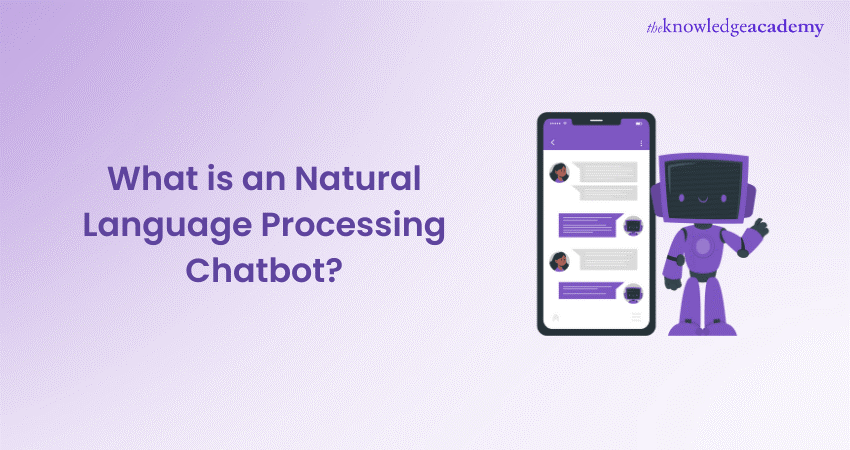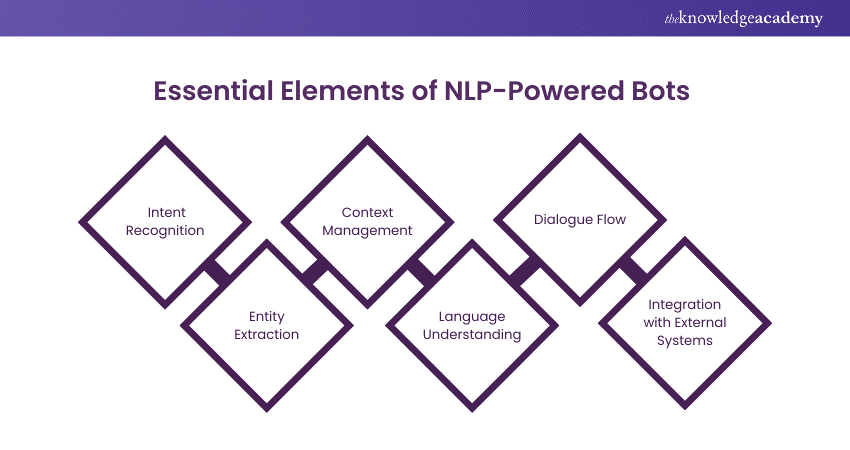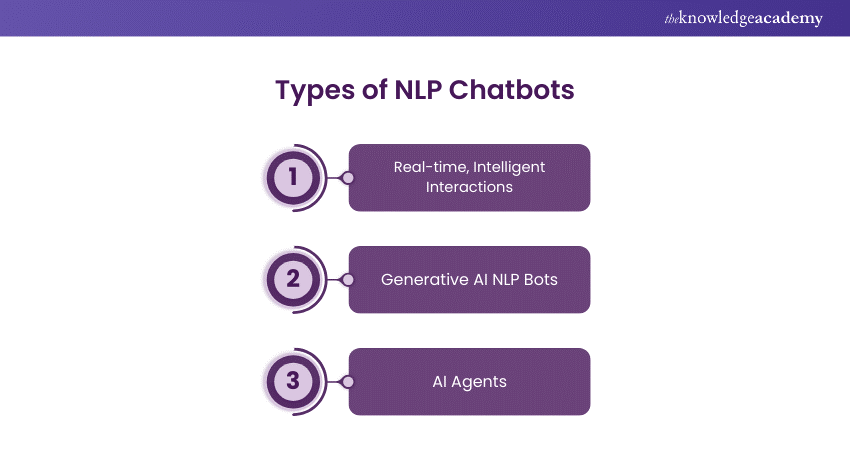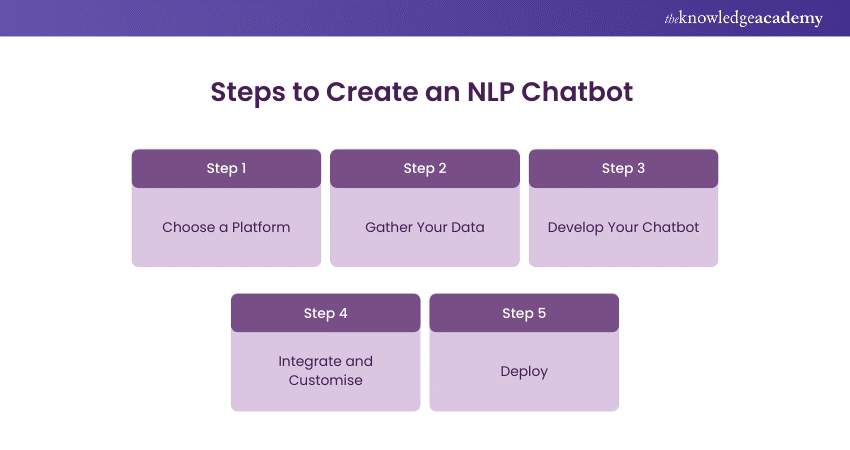We may not have the course you’re looking for. If you enquire or give us a call on +45 89870423 and speak to our training experts, we may still be able to help with your training requirements.
We ensure quality, budget-alignment, and timely delivery by our expert instructors.

Ten years ago, the idea of interacting with humans in a natural, human-like language was merely a dream. Now, as we step into 2024, it's a reality that's impossible to ignore, thanks to advancements in Natural Language Processing (NLP). NLP Chatbots represent this futuristic technology, and by 2032, they’re projected to drive nearly £350.65 billion in growth. This impressive statistic highlights the technology's rapid expansion, fueled by AI breakthroughs and rising demand across industries like healthcare, IT, and finance. In this blog, we’ll explore what NLP Chatbots are, their types, how to create them, their benefits, and much more.
Table of Contents
1) What is an NLP Chatbot?
2) Essential Elements of NLP-Powered Bots
3) How do NLP Chatbots Work?
4) Types of NLP Chatbots
5) Steps to Create an NLP Chatbot
6) Benefits of an NLP Chatbot
7) Tools for Developing NLP Chatbots
8) Best Practices for Creating and Implementing an NLP Chatbot
9) Conclusion
What is an NLP Chatbot?
NLP Chatbot is a program with specialised algorithms that can easily interact with humans by mimicking their language. The most common examples of NLP Chatbots include OpenAI’s ChatGPT, Microsoft’s Copilot, and Google’s Gemini. Here, humans' type in their questions in their preferred language and get a reply in the same way by scanning millions of alike sources on the Internet.
The other real-life example is Siri on your iPhone or Alexa from Amazon. When you say, "What's the weather today?" The NLP Chatbot processes your words, understands you are asking about the weather, and replies with the forecast, exactly how humans do.
To perform such operations, NLP Chatbots work through Artificial Intelligence (AI), where they are fed with millions of webpages through Neural Networks, just like human brains are trained. This technology has gained worldwide traction today, mainly due to the emergence of robotics technologies and automation.
Essential Elements of NLP-Powered Bots
NLP-powered bots are designed to mimic human-like conversations to enhance the interactions-experiences to be more natural and seamless. They achieve this by using sophisticated AI techniques that process language in a contextual form. Here are some of the essential elements of NLP-powered bots:

1) Intent Recognition: NLP-powered bots rely on intent recognition to accurately identify the user’s intent and purpose behind the query. This approach ensures that the bot understands exactly what the user wants to achieve.
2) Entity Extraction: Entity extraction allows bots to recognise specific details within user inputs, such as names, dates, or locations. This helps in providing more precise and relevant responses.
3) Context Management: Context management is important for maintaining the conversation flow by remembering previous interactions. This enables the bot to respond appropriately based on the ongoing dialogue.
4) Language Understanding: Language understanding is essential for handling intricacies synonyms, and phrasing variations. This capability ensures that bots can comprehend different ways of asking similar questions, to make interactions sound more natural.
5) Dialogue Flow: Dialogue flow plays a significant role in navigating through conversations smoothly. It uses predefined scripts and AI-driven responses to manage diverse user interactions effectively.
6) Integration with External Systems: Integration with external systems is important for completing specific tasks. These include processing orders, fetching information, or updating databases. This allows the bot to deliver practical value beyond just responding to queries.
Learn how chatbots work—get the Different Types of Chatbots PDF now!
How do NLP Chatbots Work?
NLP Chatbots operate by utilising the natural language processing (NLP) techniques to interpret and understand user inputs. They begin by deconstructing a user’s message into bunches of components and pinpointing key elements, ranging from intent to entities. These bots utilise algorithms to analyse the meaning behind each word and phrase.
After identifying the intent, the chatbot employs predefined responses and AI-driven models to generate a genuine reply. If additional information is required, the bot can connect with databases or APIs to fetch the necessary data. In addition, NLP Chatbots continuously learn from each interaction, enhancing their language comprehension and response accuracy over time.
Build strong fundamental NLP concepts with our Introduction To NLP Course- join now!
Types of NLP Chatbots
NLP Chatbots come in different types, with each designed to meet specific interaction needs. These bots use the application of natural language to understand and deliver effective responses and adapt to user inputs in different ways. Listed below are the types of NLP Chatbots:

1) Real-time, Intelligent Interactions
These NLP Chatbots handle dynamic conversations by understanding context and intent in real-time. They can adapt responses based on user inputs, making interactions smoother and more natural. This capability further improves customer support, as the bots can respond immediately and appropriately to rapidly changing situations.
2) Generative AI NLP Bots
Generative AI NLP bots create new responses rather than using predefined answers. By leveraging advanced models, they can produce human-like text, making them highly effective in creating personalised and engaging interactions.
3) AI Agents
AI agents are sophisticated NLP bots that go beyond simply basic conversations. They integrate with multiple systems, performing tasks such as booking appointments, processing orders, or updating information. Their broader functionality makes them ideal for complex customer service and business process automation. Exploring NLP Project Ideas can help leverage these capabilities to enhance efficiency and user experience.
Steps to Create an NLP Chatbot
Creating an NLP Chatbot requires a strategic approach to ensure it can understand and respond effectively to users. The development process involves several stages, each designed to build a functional and efficient bot. Here are the steps to perform this operation:

Step 1: Choose a Platform
To create an NLP Chatbot, start by choosing a suitable development platform. The choice depends widely on your specific requirements. These include security, ease of use, and integration capabilities. Such platforms furthermore offer built-in NLP tools, educational materials, and customisation options to drive chatbot creation.
Step 2: Gather Your Data
Next, collect data needed to train the chatbot. This includes information like customer queries, company policies, or support transcripts. Proper data collection helps the chatbot understand user inputs and provide accurate responses.
Step 3: Develop Your Chatbot
Build the chatbot using tools provided by the platform. This involves defining workflows, creating conversation paths, and integrating machine learning (ML) models for language processing. For this, many platforms offer drag-and-drop interfaces to simplify this process.
Step 4: Integrate and Customise
Integrate the chatbot with existing systems such as CRM, databases, or communication tools. Customisation of the bot’s language, tone, and features ensures it aligns with your brand and meets user needs effectively.
Step 5: Deploy
Lastly, deploy the chatbot across relevant communication channels like websites, apps, or messaging platforms. Analyse its performance and make adjustments based on user feedback to ensure it functions optimally.
Benefits of an NLP Chatbot
NLP Chatbots are designed to enhance customer experiences by using AI to understand natural language. They provide accurate, efficient, and interactive support, further improving customer satisfaction and business efficiency. Here are the benefits of NLP Chatbots:
1) Personalise Each Interaction
NLP bots tailor responses based on individual user data, creating more relevant and engaging conversations. This personalisation leads to improved customer satisfaction and higher retention rates.
2) Enhance Your Agents' Roles
By handling routine queries, NLP bots free up human agents to focus on more complex tasks. This approach enhances agents’ productivity and allows them to contribute to higher-value activities.
3) Provide Admins with Actionable Insights
NLP bots can analyse conversations, offering insights into customer behaviour, common issues, and overall interaction quality. These insights help administrators improve services and customer experiences.
4) Lower Operational Costs
Automating repetitive tasks reduces the need for large support teams. This approach leads to lower operational expenses while maintaining the essential service quality.
5) Deliver Continuous Multilingual Support
NLP bots can provide instant support across multiple languages, ensuring round-the-clock assistance for global users, regardless of language barriers.
From basics to brilliance, get started with our Master Diploma In NLP Course today!
Tools for Developing NLP Chatbots
Developing NLP Chatbots requires specialised set of tools that offer both language processing capabilities and customisation options altogether. These tools help developers to create efficient and user-friendly chatbots that cater to different industries and business needs. Here are the key tools to develop NLP Chatbots:
1) Google Dialogflow: Google Dialogflow is a widely used tool that provides advanced NLP capabilities. It makes it easily understandable of the user intent by delivering context-aware responses.
2) Microsoft Azure Bot Service: Microsoft Azure Bot Service is a popular tool among enterprises who are looking to utilise their cloud-based AI. It offers pre-built NLP models that can be customised to meet specific requirements. This tool also integrates well with other Microsoft services for a seamless workflow.
3) Botpress and Rasa: Botpress and Rasa are open-source tools that deliver more customisation and flexibility. They cater to developers who are seeking NLP solutions, providing frameworks to build highly specific and complex bots.
4) IBM Watson Assistant: IBM Watson Assistant is a strong contender for building enterprise-grade NLP Chatbots. It utilise the applications of AI to analyse user queries, automate responses, and provide analytics for continuous improvement. Furthermore, it also integrates well with various customer service platforms.
5) Amazon Lex: Amazon Lex, which powers Alexa, is designed to develop conversational interfaces using speech and text. It supports deep learning models for intent recognition and entity extraction, making it effective for creating intelligent and interactive chatbots.
Best Practices for Creating and Implementing an NLP Chatbot
Implementing an NLP Chatbot effectively requires a strategic approach, considering both technical aspects and user experience (UX). Below mentioned are the best practices for creating and implementing NLP Chatbots:
1) Define Purpose and Scope: Begin by clearly defining the purpose and scope of the NLP Chatbot. Ensure that the chatbot’s goals adequately align with user needs, whether it’s for customer service, information retrieval, or task automation. Understanding the target audience's expectations is important for creating effective design and implementation.
2) Use High-Quality Training Data: Use high-quality training data to ensure accurate responses. Training the chatbot with diverse, real-world data enables it to better understand user intent and handle variations in phrasing. Regular updates to the training data based on user interactions also enhance the bot’s accuracy over time.
3) Optimise User Experience: Optimise the user experience (UX) by focusing on the bot's interface and communication style. Create a clear dialogue flow that guides users smoothly, using simple language and providing concise responses. Additionally, ensure the chatbot can seamlessly escalate to human agents when needed to handle complex issues.
4) Testing and Continuous Monitoring: Testing and continuous monitoring are essential to maintain the chatbot’s effectiveness. You should implement regular assessments to identify areas of improvement and ensure that the bot performs as expected. Feedback from users should also be considered to refine responses and enhance the overall experience.
5) Ensure Robust Security Measures: Ensure robust security measures when creating and implementing an NLP Chatbot. It works by protecting user data through secure communication channels, encryption, and data protection regulation compliances. This approach builds user trust and ensures the safe handling of sensitive information.
Master essential NLP techniques from the ground level- sign up for our NLP Foundation Course today!
Conclusion
We hope you understood this topic on NLP Chatbots. These AI-powered tools are transforming how businesses are interacting with customers through personalised and multilingual support. Whether for customer service or complex tasks, implementing NLP Chatbots can severely boost productivity and minimise costs. Furthermore, as you build your own chatbot, following best practices and using the right tools will ensure the successful deployment of your NLP Chatbots.
Achieve NLP practitioner status—unlock complex strategies with our NLP Master Practitioner Course!
Frequently Asked Questions
What is the Difference Between NLP and ChatGPT?

Both NLP and ChatGPT are highly cutting-edge technology. Natural Language Processing (NLP) primarily works by enabling machines to understand and process human-like language. While ChatGPT is designed to generate human-like text responses during query conversations with users.
Is NLP the Future of AI?

Yes, NLP is definitely the future of AI. Moreover, as AI continues to evolve, NLP is expected to drive more advanced human-computer interactions, enabling machines to understand, process, and respond to human language more naturally.
What are the Other Resources and Offers Provided by The Knowledge Academy?

The Knowledge Academy takes global learning to new heights, offering over 30,000 online courses across 490+ locations in 220 countries. This expansive reach ensures accessibility and convenience for learners worldwide.
Alongside our diverse Online Course Catalogue, encompassing 19 major categories, we go the extra mile by providing a plethora of free educational Online Resources like News updates, Blogs, videos, webinars, and interview questions. Tailoring learning experiences further, professionals can maximise value with customisable Course Bundles of TKA.
What is The Knowledge Pass, and How Does it Work?

The Knowledge Academy’s Knowledge Pass, a prepaid voucher, adds another layer of flexibility, allowing course bookings over a 12-month period. Join us on a journey where education knows no bounds.
What are the Related Courses and Blogs Provided by The Knowledge Academy?

The Knowledge Academy offers various NLP Training, including Introduction to NLP Course, NLP Foundation Course, and NLP Master Practitioner Training. These courses cater to different skill levels, providing comprehensive insights into the 4 Pillars of NLP.
Our Business Skills Blogs cover a range of topics related to professional growth and skill development, offering valuable resources, best practices, and industry insights. Whether you are a beginner or looking to advance your business management skills, The Knowledge Academy's diverse courses and informative blogs have got you covered.
Upcoming Business Skills Resources Batches & Dates
Date
 NLP Foundation and Practitioner Training
NLP Foundation and Practitioner Training
Mon 3rd Mar 2025
Mon 9th Jun 2025
Mon 8th Sep 2025
Mon 3rd Nov 2025
Mon 1st Dec 2025






 Top Rated Course
Top Rated Course



 If you wish to make any changes to your course, please
If you wish to make any changes to your course, please


